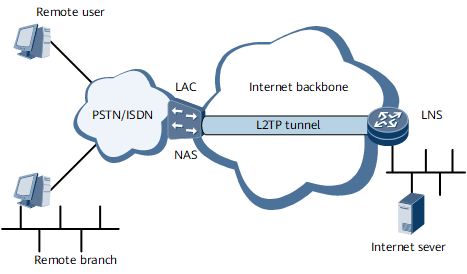L2TP QoS Fundamentals
As shown in Figure 1, users need to log in to a private network through a Layer 2 network.
The LAC is a Layer 2 network device that can process PPP packets and support L2TP functions. Usually it is an access device on the local Internet Service Provider (ISP) network. The LAC is deployed between an LNS and a remote system (a remote user or a remote branch).
The LAC performs traffic rate limiting, flow queue mapping, and traffic scheduling.
The LNS is the receiving end of a PPP session. Users authenticated by the LNS can log in to the private network to access resources.
The LNS can also perform traffic rate limiting, flow queue mapping, and traffic scheduling.
The LNS supports the following QoS scheduling modes:
Tunnel-specific scheduling
In this mode, services of each user are not differentiated, and therefore there is no need to allocate a Subscriber Queue (SQ) for each user. Instead, an L2TP tunnel is allocated an SQ.
Session-specific scheduling
In this mode, each user is allocated an SQ and an L2TP tunnel is allocated a Group Queue (GQ). Each user has one to eight Priority Queues (PQs) on which Strict Priority (SP) scheduling or Weighted Fair Queue (WFQ) scheduling can be performed.
